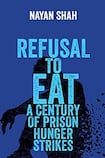
As I write this review, the news pops up that Palestinian political prisoner Hisham Abu Hawash, who has been held without charges under “administrative detention” since October 2020 in Israel’s extensive system of political prisons, will end his 141-day hunger strike on the brink of death. As a result of successful negotiations to end his detention, and in face of Islamic Jihad’s threats of an “explosion” in the event of his death, Israel has agreed not to renew his detention order.
Abu Hawash’s case encapsulates all the complexities of hunger striking that Nayan Shah explores in Refusal to Eat. Hunger striking is a familiar topic to Irish readers, summoning the ghosts of Terence MacSwiney and Bobby Sands. Indeed, one might almost think that, like the boycott, hunger striking bears an Irish logo. Turkish prisoners, after all, referred to their own hunger strike as “doing a Sands”. But, as Shah is at pains to show, the Irish experience, from Brixton Prison to the H-Blocks, is only one node in an international and constantly shifting practice of prison and political protest. His book discusses not only MacSwiney (and his sister Mary who went on hunger strike against the Free State in Mountjoy) and the H-Block 10, but also suffragettes in England and the United States; Gandhi’s “protest fasts”, which he is at pains to distinguish from prison hunger strikes by other Indian independence activists; Japanese-American internees at Tule Lake camp during the second World War; and the “enemy combatants” indefinitely held in the memory hole of Guantánamo. As Shah recounts, his own interest in the practice was sparked by being in South Africa towards the end of Apartheid, when ANC prisoners were on hunger strike.
Not unlike the colonial practices of counter-insurgency, to which it is most often a response, hunger striking is a truly international phenomenon. As Shah argues, it is also one whose forms, goals and outcomes constantly vary according to local and contingent conditions and in relation to the increasingly sophisticated and medicalised response of prison authorities. Though we are all too familiar in Ireland with the lugubrious tallying up of days that seems always a countdown towards the striker’s death, most hunger strikes do not end in death, as Shah points out. Gandhi’s protest fasts, while taxing and spectacular, always had a limited duration announced in advance. He strongly opposed the hunger strike to the death, which sought to impose moral pressure on the state, and regarded his fasts as a form of exemplary spiritual purification. Sometimes a mass strike may be called off as one or more of the participants approaches a crisis – as was the case with the collective H-Block action that determined the Blanketmen to launch the eerie and seemingly unique phenomenon of the serial hunger strike in which 10 men died at carefully spaced intervals. In other instances, it is the intervention of the prison authorities that forestalls the prisoner’s death, usually in the form of force feeding.
One of the strengths of this book is its extensive exploration of the ways in which states have gradually medicalised their response to the hunger strike. In 1913 English authorities used crude force-feeding techniques to break the hunger strike of Marion Wallace Dunlop and other suffragettes. Despite the increasing sophistication of such techniques and decades of study of the effect of extended fasting on the body, the violent insertion of rubber tubes into the nasal or rectal passages of captives in Guantanámo or in Israel’s notorious high-security jails remains excruciatingly painful; it is tantamount to torture, according to the International Medical Association. This raises serious ethical questions for the medical staff drafted to perform this procedure.
Hunger striking is also a weapon that can transform the vulnerable and disempowered body of the captive into a remarkably effective instrument in a war for legitimacy
The ethical issues point to a larger dilemma as to how far the prison authorities or medical staff are entitled to contravene the autonomous and rational choice of the prisoner to refuse to eat as a form of protest. In some senses, this is the crux of Shah’s book. As he shows in great detail and citing numerous cases – from the US prison system, where prisoners held for years in solitary confinement succeeded in launching a mass strike, to Turkey’s jailed Kurdish activists or Indian feminist Irom Sharmila’s extraordinary 16-year ordeal – the state’s aim in force-feeding is less to preserve the life of the prisoner than to break the strike. Force-feeding, and the pathologisation of the prisoner as a medical case rather than a political activist, seeks to isolate the prisoner who acts in the name of a collective struggle for rights. Rather than being a healer, the doctor becomes an instrument of the prison regime’s imperative to restore discipline and conformity.
Above all, the aim of the state is to prevent hunger strikers from achieving their main goal, which is not death but communication. As Shah succinctly puts it, where “carceral power isolates” the hunger strike “marshals the human body to communicate over prison barricades to the public”. Numerous studies of the H-Block struggle have detailed the remarkable capacity of the prisoners to find ways to smuggle their accounts out of the prison and to take control of the narrative. And just as in their case, the publicity that Abu Hisham’s case received and the protests it generated across the West Bank, despite his isolation, forced feeding and portrayal as a terrorist, was instrumental in attaining his release.
Shah recognises that the hunger strike is a nonviolent performance that reconnects the prisoner to her community and to the world of journalism and public debate. But it is also a weapon that can transform the vulnerable and disempowered body of the captive into a remarkably effective instrument in a war for legitimacy. This paradox of the weaponisation of the spectacularly suffering body, which underlay Gandhi’s fierce rejection of hunger striking, remains at the core of arguments about the ethics of the hunger strike. Hunger striking is a “weapon of the weak”, a demand that we reject the criminalisation of those who oppose the power and injustice of the state, and act in solidarity with them. The emaciated, mortal body inflicts a counterviolence against the state and the violence of its categories and its cells alike. Reaching beyond the prison wall, the voice of the hunger striker implicates us all in its challenge to decide what world we seek to inhabit.
David Lloyd is distinguished professor of English at University of California














